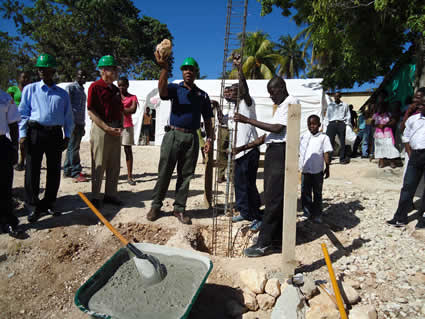In my travels to Haiti since the earthquake, much of the landscape has changed.

Laying the foundation for the Capitol Child Development Center in Haiti
Rubble that once filled the streets has been cleared. Many of the crumbled buildings are replaced by newer ones. The tent cities where tens of thousands of evacuees were forced to live are now gone from many of the city parks and street sides.
The interior landscapes of individual lives are changing, too.
For a number of Haitians, fear is being challenged by hope. Optimism is battling against fatalism. I even learned a new Creole phrase, “Degaje” (pronounced day-gah-jhay.) It means, “We will overcome.”
You have to understand how important that is. In the past, you rarely heard that message in Haiti. In a country devastated by poverty for decades, fatalism and hopelessness kept the phrase off their lips.
But on this trip, I heard “degaje” repeatedly — a word of hope literally rambling around the city and hovering above the wreckage.
But full disclosure demands more. Everything in Haiti is not fine.
Dig a little deeper and you discover that the tent cities in the middle of Port-au-Prince have merely moved. The government gave relief money that flowed in from around the world to Haitians in order to move somewhere else.
They took the money and simply pitched their tents or built shacks on the same type of steep hillsides that proved to be death-slopes during the earthquake. And when the rains and hurricanes come again, those hillsides are prime targets for flooding and mudslides.
Even more troubling are the construction techniques I witnessed. The same low standards that brought Haiti to its knees are being used again in an attempt to help it rise.
I saw one collapsed building that had used PVC pipe in place of rebar. No wonder it was flattened.
Even today cinderblock and concrete aren’t being reinforced with rebar. Lift a Haitian block and you’d be surprised at how lightweight it is. If you dropped it, you’d be alarmed at how easily it shatters.
The price of poverty is paid in substandard materials.
But here, at the school built through the generosity of Compassion child sponsors and donors, it’s a different story, but a story that’s been challenging to write nevertheless.
We had to tap engineers and architects from other parts of the world to design earthquake-resistant foundations, walls and roofs. We had to identify and train a supplier in Haiti to manufacture quality cinder blocks — not just cinderblocks that were inexpensive. The iron for rebar and roof trusses required a meticulous search.
And all of the materials have to undergo random inspection by the only quality-assurance testing lab in Haiti. Even during construction, project foremen live on-site to guide progress and quality.
It took time and diligence, but the result is a building that is safe and sound within a reasonable cost per structure. It can be done.







2 Comments |Add a comment
Great article about the challenges of working in Haiti. We set out to build a company in Haiti that would produce world-class construction materials because how could we let Haiti be rebuilt as it was before. By God’s grace, we are now manufacturing in Haiti US-Grade Concrete Block at the rate of 16,000 units per day. Compassion is dedicated to using high quality materials like ours and rebuilding Haiti to last.
Most hope filled phrase I’ve heard yet in regard to Haiti: “It can be done.”. Praise God from whom ALL blessings flow!